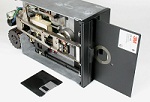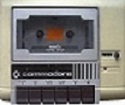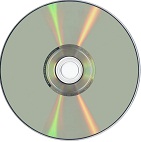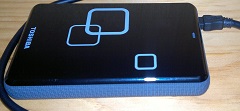
1960's
 •
Punched Card – Earliest known use was in 1801, where it was used as an automated instruction card for controlling
weaving looms. In 1846, they were used for sending telegrams. Computer use began in the mid to late 1950’s, where they were
used for data input and storage. Numerous formats were instituted until 1969, where American National Standard defined the
Hollerith Punched Card Code as the standard.
Learn More
•
Punched Card – Earliest known use was in 1801, where it was used as an automated instruction card for controlling
weaving looms. In 1846, they were used for sending telegrams. Computer use began in the mid to late 1950’s, where they were
used for data input and storage. Numerous formats were instituted until 1969, where American National Standard defined the
Hollerith Punched Card Code as the standard.
Learn More
 •
Punched Tape – computer input and data storage medium. Earliest known use was approximately 1846, where it was used to
for telegrams. Data was stored using several different encoding languages in the 19th and early 20th century. In the early
1960’s, a universal code was introduced, known as ASCII.
Learn More
•
Punched Tape – computer input and data storage medium. Earliest known use was approximately 1846, where it was used to
for telegrams. Data was stored using several different encoding languages in the 19th and early 20th century. In the early
1960’s, a universal code was introduced, known as ASCII.
Learn More

 •
Magnetic Tape – First used in 1951 with the UNIVAC 1, the second commercial computer produced in the USA. While it has
uses with audio and video storage, it is its capability with data storage
Learn More
•
Magnetic Tape – First used in 1951 with the UNIVAC 1, the second commercial computer produced in the USA. While it has
uses with audio and video storage, it is its capability with data storage
Learn More
 •
8" Floppy Disk – Developed in the late 60’s, the floppy disk measured 8 inches, was a Read-only medium, and only
had an 80kB data capability. It wasn’t until the early 1970’s that they came into commercial use.
Learn More
•
8" Floppy Disk – Developed in the late 60’s, the floppy disk measured 8 inches, was a Read-only medium, and only
had an 80kB data capability. It wasn’t until the early 1970’s that they came into commercial use.
Learn More
 •
Hard disk drive – Developed by IBM in 1956. The IBM 350 utilized fifty 24” disk platters, but stored only 3.75 MB. was
as large as a washing machine and stored data on interchangeable disk packs.
Learn More
•
Hard disk drive – Developed by IBM in 1956. The IBM 350 utilized fifty 24” disk platters, but stored only 3.75 MB. was
as large as a washing machine and stored data on interchangeable disk packs.
Learn More
1970's

• Floppy Disk In 1971 the floppy disk first became available on the market. The development of the floppy disk was headed by Warren L. Dalziel at IBM. The first format was 8inches wide and contained just 80kB of memory. Later developments increased that size to 1.2MB.
Learn More

 • Cassette Tape The cassette tape was introduced in 1972 with capacity of around 660 kilobytes per side of a 90-minute tape. These tapes required a specialized tape recorder to load and save data, and load programs.
Learn More
• Cassette Tape The cassette tape was introduced in 1972 with capacity of around 660 kilobytes per side of a 90-minute tape. These tapes required a specialized tape recorder to load and save data, and load programs.
Learn More
 • Laserdisc videodisc was first demonstrated in 1972. It was developed by David Paul Gregg, and old to Phillips. Laserdisc discs were 12 inches in diameter and dual sided. The dual sides were created by glueing two single sided disks together. Each side could hold about 60 minutes of video. In 1978, laserdisc were made available to the market and consumers.
Learn More
• Laserdisc videodisc was first demonstrated in 1972. It was developed by David Paul Gregg, and old to Phillips. Laserdisc discs were 12 inches in diameter and dual sided. The dual sides were created by glueing two single sided disks together. Each side could hold about 60 minutes of video. In 1978, laserdisc were made available to the market and consumers.
Learn More
 • Fairchild Channel F was released in 1976. This was the first console to use ROM cartridges. Ever since, many gaming systems and some computers have used cartridges to load programs or games, and store data.
Learn More
• Fairchild Channel F was released in 1976. This was the first console to use ROM cartridges. Ever since, many gaming systems and some computers have used cartridges to load programs or games, and store data.
Learn More
 • 5 1/4" Floppy Disk In 1976, a smaller version of the original floppy disk was introduced. This version was 5.25 inches, and had a capacity of 87.5 kB. Since introduction, 5.25" can store up to 1.2MB of data.
Learn More
• 5 1/4" Floppy Disk In 1976, a smaller version of the original floppy disk was introduced. This version was 5.25 inches, and had a capacity of 87.5 kB. Since introduction, 5.25" can store up to 1.2MB of data.
Learn More
1980's
 •CD- In 1980, a prototype for the compact disc was presented to Sony by a man named James T Russell. He came up with the idea of recording and replaying music with the use of light. He filed his patent application in 1966 and it was granted in 1970. He then invented the optical digital television recording and playback television in 1970, unfortunately nobody took to his invention, however in 1975, The electronics company Philips paid Russell millions for him to create the compact disc. That’s when the prototype was introduced to Philips and Sony.
Learn More
•CD- In 1980, a prototype for the compact disc was presented to Sony by a man named James T Russell. He came up with the idea of recording and replaying music with the use of light. He filed his patent application in 1966 and it was granted in 1970. He then invented the optical digital television recording and playback television in 1970, unfortunately nobody took to his invention, however in 1975, The electronics company Philips paid Russell millions for him to create the compact disc. That’s when the prototype was introduced to Philips and Sony.
Learn More
 • 3.5" Floppy Disk- also known as the diskette is a thin and flexible magnetic storage medium which is sealed in a rectangular shaped plastic carrier that is lined with fabric to help remove dust particles. Throughout the 80s there was a 5 and a quarter inch format and by 1988 there was a 3 ½ inch format with the storage capacity of 360 kilobytes and 720 kilobytes. The 3.5” outsold the 5 and a quarter inch version. By the end of the 1980s the 5 and a quarter inch version was suspended.
Learn More
• 3.5" Floppy Disk- also known as the diskette is a thin and flexible magnetic storage medium which is sealed in a rectangular shaped plastic carrier that is lined with fabric to help remove dust particles. Throughout the 80s there was a 5 and a quarter inch format and by 1988 there was a 3 ½ inch format with the storage capacity of 360 kilobytes and 720 kilobytes. The 3.5” outsold the 5 and a quarter inch version. By the end of the 1980s the 5 and a quarter inch version was suspended.
Learn More
 •CD Rom- The CD-ROM stands for Compact Disk Read Only Memory which uses the same physical format as the audio compact disks to store digital data. CD-ROMs can store more data than a floppy disk. It can hold up to 650 megabytes of storage. Computers are able to read CD-ROMs but do not have the capability of writing on the CD-ROMS.
Learn More
•CD Rom- The CD-ROM stands for Compact Disk Read Only Memory which uses the same physical format as the audio compact disks to store digital data. CD-ROMs can store more data than a floppy disk. It can hold up to 650 megabytes of storage. Computers are able to read CD-ROMs but do not have the capability of writing on the CD-ROMS.
Learn More
1990's
 • CD-R- Year: 1990. Description: A CD-R disc is a compact disc that can be written once and read arbitrarily many times. Capacity: 700 mb. Phased Out:
• CD-R- Year: 1990. Description: A CD-R disc is a compact disc that can be written once and read arbitrarily many times. Capacity: 700 mb. Phased Out:
 •Mini Disc- Year: 1992. Description: Mini Discs used magneto-optical technology and were created to replace cassette tapes and very similar to CD’s. It was mainly used to audio, never data storage. Capacity: 74 minutes and, later, 80 minutes, of digitized audio or 1 gigabyte of Hi-MD data. Phased Out: obsolete
•Mini Disc- Year: 1992. Description: Mini Discs used magneto-optical technology and were created to replace cassette tapes and very similar to CD’s. It was mainly used to audio, never data storage. Capacity: 74 minutes and, later, 80 minutes, of digitized audio or 1 gigabyte of Hi-MD data. Phased Out: obsolete
 •Compact Flash- Year: 1994. Description: memory mass storage device primarily used in portable electronic devices. They were manufactured by SanDisk in 1994. It was the most successful out of early memory cards such as picture cards, memory stick, and smart media. Capacity: around 100 GB. Phased Out: still in use
•Compact Flash- Year: 1994. Description: memory mass storage device primarily used in portable electronic devices. They were manufactured by SanDisk in 1994. It was the most successful out of early memory cards such as picture cards, memory stick, and smart media. Capacity: around 100 GB. Phased Out: still in use
 •Zip Drive (disks)- Year: 1994-2003. Description: inexpensive storage which was removable floppy system created by Lomega. It started out with 100 mb but later versions went from 250 mb to 750 mb. Capacity: 100 mb-750 mb. Phased Out: because it could never replace 3.5 floppy disk or compete with storage size or rewriteable CDs.
•Zip Drive (disks)- Year: 1994-2003. Description: inexpensive storage which was removable floppy system created by Lomega. It started out with 100 mb but later versions went from 250 mb to 750 mb. Capacity: 100 mb-750 mb. Phased Out: because it could never replace 3.5 floppy disk or compete with storage size or rewriteable CDs.
•Jaz Drive- Year: 1995-2002. Description: Sold by Lomega, Jaz drives are removable hard disk storage systems. It is most compared to hard drives than floppy drives like the zip drives. They had several issues, such as overheating, discs getting stuck in the drive, susceptible to contaminants in the drive, among many other problems. Capacity: 1 GB, 2 GB by 1998. Phased Out: due to popularity and decreasing price of CD-R/CD-RW.
•DVD- Year: 1995- present. Description: A digital optical disc storage medium. Invented and developed by Philips, Sony, Toshiba, and Panasonic in 1995. ] DVDs offer higher storage capacity than compact discs while having the same dimensions. Capacity: 4.7- 8.5 GB (dual layer). Phased Out: still used.
•LS-120 or SuperDisk- Year: 1997-2000. Description: A later version of the zip drive, the SuperDisk created by 3M is a high capacity alternative of the 3.5 floppy disk. It was supposed to have better performance and to be backwards compatible with 1.44MB and 720KB floppy disks. Capacity: 120 mb , later 240 mb. Phased Out: obsolete due to zip drive 3 years prior and falling prices of CD-R/ CD-RW and usb/flash drives.
2000's
 •USB Flash drive- Year: Jan 2000. Description: Cost between $20 -$200. Capacity: 250 mb – 6 gb. Phased Out: presently using. Beaten out by: n/a.
•USB Flash drive- Year: Jan 2000. Description: Cost between $20 -$200. Capacity: 250 mb – 6 gb. Phased Out: presently using. Beaten out by: n/a.
 •SD card- Year: August 2000. Description: smaller, larger capacity, and faster speed than compact flash and memory sticks. Capacity: 32mb. Phased Out: presently using. Beaten out by: n/a.
•SD card- Year: August 2000. Description: smaller, larger capacity, and faster speed than compact flash and memory sticks. Capacity: 32mb. Phased Out: presently using. Beaten out by: n/a.
 •2.5” Portable Hard Drive- Year: August 2000- Present. Description: Also known as external hard drive, the 2.5 portable hard drives are high capacity data storage devices. Most have a 2.0 usb interface and offer automatic or push-button backup solution, with capacities reaching as high as 1TB. Capacity: up to 1TB. Phased Out: presently using.
•2.5” Portable Hard Drive- Year: August 2000- Present. Description: Also known as external hard drive, the 2.5 portable hard drives are high capacity data storage devices. Most have a 2.0 usb interface and offer automatic or push-button backup solution, with capacities reaching as high as 1TB. Capacity: up to 1TB. Phased Out: presently using.
•HD- DVD. Year: 2006-2008- Description: High density optical disc for storing data and HD(high definition ) video. It was made to be the successor to the DVD. Capacity: around 15 GB (single layer), 30 GB (dual layer). Phased Out: 2008, Toshiba decided not to develop or manfufactor hd dvd players or drives due to losing battle with blu ray.
•Blu Ray- Year: 2006- present. Description: A digital optical storage medium made to supersede the DVD. It can storage HD video (1024p resolution). Key Distributors: feature films, Playstation 3, Playstation 4, and Xbox One. Capacity: 25 GB (single-layer), 50 GB (dual-layer). Phased Out: presently using.
•Cloud Storage- Year: April 2011. Description: online storage, pay per use, up to specified amount. Capacity: Infinite. Phased Out: presently using.
